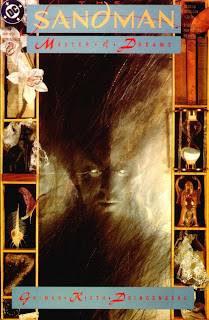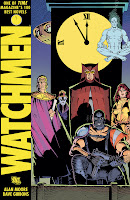One day, as I was browsing one of my most favorite bookstores, a new section quickly caught my attention. The sign above it said:
GRAPHIC NOVELS
"Wow!" I thought to myself. "It sounds so sophisticated!"
So I broke my intended route in order to investigate this alien part of the bookstore. I stood in front of the shelf, gawking at its colorful exterior. All of a sudden, familiar names sprung up as I traced their spines with my eyes, such as; Marvel, X-Men, DC,
 Wolverine, Avengers and Superman! I hastily grabbed the most accessible book and flipped through its pages; this gave me a realization of some sort (something like an Aha! moment but not really). I held in my hands a comic book, but on steroids!
Wolverine, Avengers and Superman! I hastily grabbed the most accessible book and flipped through its pages; this gave me a realization of some sort (something like an Aha! moment but not really). I held in my hands a comic book, but on steroids!"Cool."
Another realization hit me as fast as the first one did as I flipped the Graphic Novel over; it was expensive! Nevertheless, I still thought it was pretty cool so whenever my parents were extra generous with my allowance I would save up and buy one.
This happened years ago when bookstores wouldn't really know where to index these thick clumps of paper so they decided to create whole new sections for them. Today, the term "Graphic Novel" has tremendously increased in popularity. Though it's not really a household term just yet, most avid comic book readers know what the term means. Well, they think they know what it means. Why do I say this? It's probably due to the fact that there is still no proper and universally accepted definition for "Graphic Novel."
In this article, I will not undertake the colossal task of defining the Graphic Novel. I'll leave that to experts who have more experience in that craft. Instead, I aim to give you, the reader, a general understanding of what Graphic Novels are. Okay? Let’s start.
 WHAT IS A GRAPHIC NOVEL? (for general understanding purposes)
WHAT IS A GRAPHIC NOVEL? (for general understanding purposes)Graphic Novels came from Comic Books. I know that this is a pretty obvious statement and most of you who are probably reading this right now already knew that to begin with. I mean, the evidence is right there once you open the graphic novel—you see comics. The content of any one of these books will show you forms of paneling, plots and premises; and combinations of pictures and dialogue that we have already come to know and love from reading comic books. But why do people call them Graphic Novels? They have the same content anyway so why don’t they just call them long Comic Books? What sets them apart from their Comic Book forefathers? Let’s take a look at a couple of differences between the two:
1. Comic Books usually range from 12-24+glossy pages covered by material used for magazines. For Graphic Novels, It’s very uncommon to find these with less than 30 pages; most Graphic Novels easily reach 60-100+. Though they also use glossy pages for the inside, most of the bindings now use the same material as conventional books. Most of them also have dust covers.
2. Most comic books are usually parts of a series, meaning you wouldn’t really get the whole story by just buying one. Graphic Novels, on the other hand, have complete stories inside their covers, even if they’re just collections of a number of comic books. You’d still have the complete satisfaction of having a beginning and an end, just like normal books.
3. For some reason, libraries and bookstores prefer to stock Graphic Novels instead of normal comic books. Even though it’s a compilation of numerous comics you’d still probably find it under the Graphic Novels section. Moreover, they are more library-friendly than their thinner counter-parts.
As you can see, there is still a very fine line between comic books and graphic novels. The examples that I gave above are only differences that are easily observed or interpreted. The truth is, I don’t think most people would even complain if you called a comic book a graphic novel or vice versa.
Which brings us to this question; “So if they’re just almost the same thing, why did they have to make up the term Graphic Novel?”
Well, dear reader, I believe that this is due to the fact that the term Graphic Novel is just much more pleasing to the ears and eyes than its counterpart. When we hear the word comics, most often then not, we immediately attach the idea of funny or humorous to it. This shouldn’t
 really come as a surprise to us. So if I wanted to submit a comic that was darker, brutally realistic and shockingly mature; how do I get rid of the comedic connotation? We exchange Comic Book with a much more “sophisticated” term, such as Graphic Novel (notice how I used the quotation marks there). I have no qualms against this though, I mean it’s really up to the writer/artist to call his work whatever he wants to and if he’s calling it a Graphic Novel then fine, no problem. It can also be a good way for comic books to “grow up” and reach for more mature audiences and wider markets, gaining the attention it rightfully deserves. So, I really don’t think it’s a bad thing at all.
really come as a surprise to us. So if I wanted to submit a comic that was darker, brutally realistic and shockingly mature; how do I get rid of the comedic connotation? We exchange Comic Book with a much more “sophisticated” term, such as Graphic Novel (notice how I used the quotation marks there). I have no qualms against this though, I mean it’s really up to the writer/artist to call his work whatever he wants to and if he’s calling it a Graphic Novel then fine, no problem. It can also be a good way for comic books to “grow up” and reach for more mature audiences and wider markets, gaining the attention it rightfully deserves. So, I really don’t think it’s a bad thing at all.In my opinion, Graphic Novels are essentially just comic books too. Someone just had to repackage it in order to get more readers or to change it’s image or whatever, I’m not sure. It all boils down to what’s in between the covers anyway.
Hope this helps even though I’m not sure how it will.
By the way, KEEP READING!
KBGBDK4CATVV



No comments:
Post a Comment